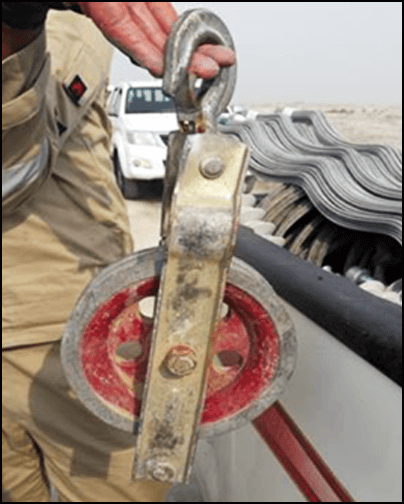-
What happened?
A worker was conducting power line stringing operations on top of a tower when a 3kg (6.6lbs) wire pulley fell 26 meters (85 feet) to the ground.
No one was in the drop zone at the time so there were no injuries.

-
Why did it happen?
The workers did not comply with the method statement (procedure) and job safety analysis (JSA) referring to establishing barriers around drop zones and tethering tools and equipment when working at height:
- The worker failed to tether the pulley to the tower lattice structure and didn’t recognise the stored energy potential for un-tethered equipment. When he shifted his body position, the pulley dropped.
- Workers were not executing hazard controls listed in the JSA.
- Entry into barricaded areas (red zone) was not strictly enforced. Teams did not intervene when observing workers entered these areas.
- Last minute risk assessment (e.g., step back 5x5 - step back five paces from the job and spend five minutes planning) were not used to confirm JSA or to address changing conditions.
Line management (supervision) did not consistently verify conformance with safety requirements.

-
What did they learn?
Ensure that personnel follow the hazard controls included in job safety analysis (JSA).
Make sure everyone recognises the working at height (WAH) life saving rule (LSR) requirement to secure all tools and work materials.
Ensure personnel stay out of barricaded/exclusion/red zone areas.
Supervisors should verify that work teams can describe task hazard controls and confirm that the person(s) responsible for those controls are executing effectively.

-
Ask yourself or your crew
How can something like this happen here?
How can you check if all risks have been considered in the JSA?
What checks do you perform before starting your task today? Are there any additional checks required for working at height?
What measures do we have in place to ensure that all personnel are fully aware of safe work procedures?

Add to homescreen
Content name
Select existing category:
Content name
New collection
Edit collection
What happened?
A worker was conducting power line stringing operations on top of a tower when a 3kg (6.6lbs) wire pulley fell 26 meters (85 feet) to the ground.
No one was in the drop zone at the time so there were no injuries.

Why did it happen?
The workers did not comply with the method statement (procedure) and job safety analysis (JSA) referring to establishing barriers around drop zones and tethering tools and equipment when working at height:
- The worker failed to tether the pulley to the tower lattice structure and didn’t recognise the stored energy potential for un-tethered equipment. When he shifted his body position, the pulley dropped.
- Workers were not executing hazard controls listed in the JSA.
- Entry into barricaded areas (red zone) was not strictly enforced. Teams did not intervene when observing workers entered these areas.
- Last minute risk assessment (e.g., step back 5x5 - step back five paces from the job and spend five minutes planning) were not used to confirm JSA or to address changing conditions.
Line management (supervision) did not consistently verify conformance with safety requirements.

What did they learn?
Ensure that personnel follow the hazard controls included in job safety analysis (JSA).
Make sure everyone recognises the working at height (WAH) life saving rule (LSR) requirement to secure all tools and work materials.
Ensure personnel stay out of barricaded/exclusion/red zone areas.
Supervisors should verify that work teams can describe task hazard controls and confirm that the person(s) responsible for those controls are executing effectively.
Ask yourself or your crew
How can something like this happen here?
How can you check if all risks have been considered in the JSA?
What checks do you perform before starting your task today? Are there any additional checks required for working at height?
What measures do we have in place to ensure that all personnel are fully aware of safe work procedures?
A wire pulley fell 26 metres (85 feet) to the ground when a worker was conducting power line stringing operations. Nobody was in the drop zone at the time so there were no injuries.












